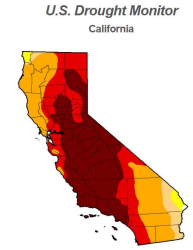The Governor’s Drought Order
 Governor Brown’s April announcement that California is in a severe drought was far from a surprise. No spring rains are coming to rescue us this year as we embark on the 4th year of drought – according to tree ring data, California’s worst in 13,000 years.
Governor Brown’s April announcement that California is in a severe drought was far from a surprise. No spring rains are coming to rescue us this year as we embark on the 4th year of drought – according to tree ring data, California’s worst in 13,000 years.
This is a serious problem, for communities, farms and the environment. The governor took a series of executive actions, but are they enough? No, but it’s a good start and more than any governor has done before him.
Urban Conservation: What did the governor’s order do? It requires 25% mandatory conservation, and banned new developments from using potable water for irrigation unless they’re on a drip system. It also provides funds to pay rebates for water-saving appliances, and a huge lawn removal “cash for grass” program.
What more could be done? How about helping low-income homes that can’t take advantage of the rebate program? Or requiring new developments to be “water-neutral”, with any new water demand offset by payments into the local water conservation program sufficient to fully offset the net water demand?
Because of it’s low per capita usage, San Francisco’s conservation target will be 8%, which means maintaining the level of conservation we’ve achieved over the past 2 years.
Should San Francisco limit new development? Perhaps, but from a water perspective, the new developments are extremely efficient, more so since the SFPUC is now encouraging the installation of on-site recycled water systems that treat wastewater and recirculate it within the building for nonpotable uses like toilet flushing or irrigation.
Agriculture: The governor is requiring mandatory reporting of water levels and the development drought management plans (yes, a bit late), and is also promoting grants for installation of water-saving technology (more drip, less flood)!
While agriculture was not given conservation targets, the state and federal projects are delivering between zero and 20% of contracted water supplies, so many agricultural areas are being impacted. Last year, when precipitation was about half of normal about 5% of agricultural land was fallowed; that number will almost certainly increase this year.
What more could be done? How about issuing a moratorium on new plantings of permanent crops? Or a ban in opening up new irrigated acreage during the drought?
Industrial Water Use: The only industry targeted by the governor was golf, and his calls for large reductions in water use for large landscapes were short on details.
What more could be done? How about requiring bottling plants that draw directly from streams and aquifers to report their water use and be prepared to reduce productions to meet the governor’s conservation goals? Oil and gas extraction doesn’t require potable water, so why not place a moratorium on its use during drought periods? Why not require golf courses to reduce the amount of turf to what is actually needed for play?

